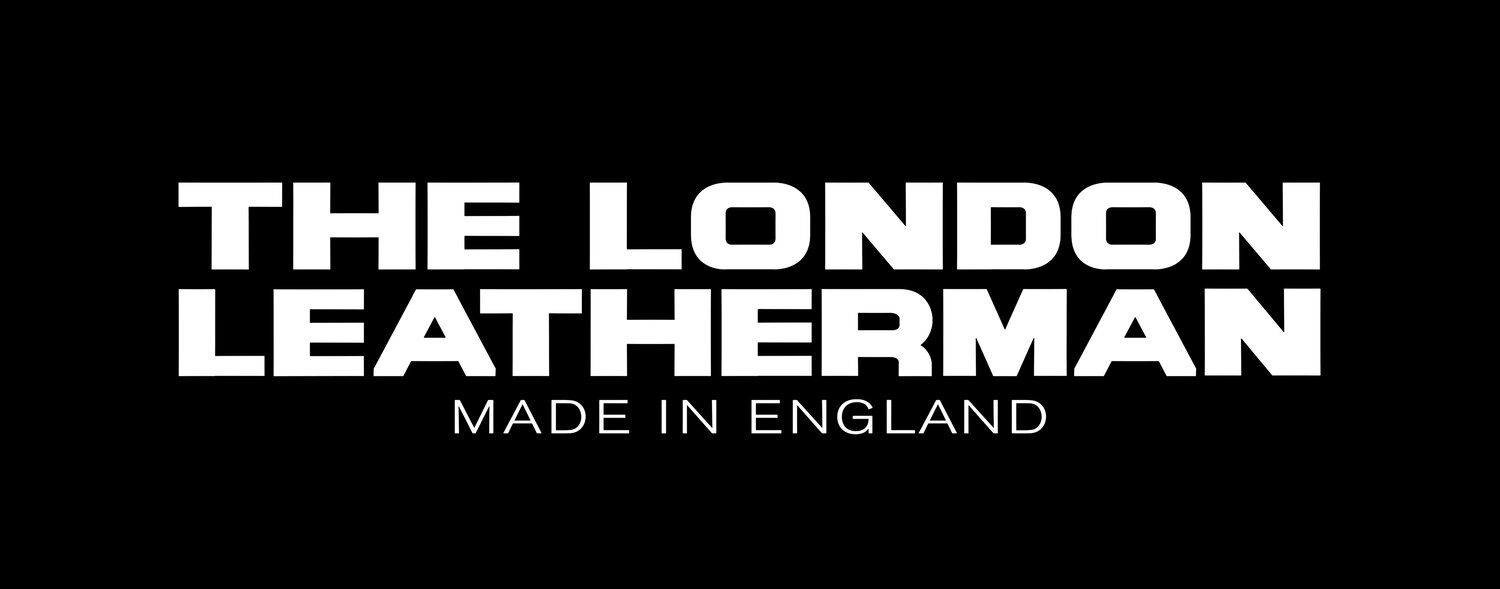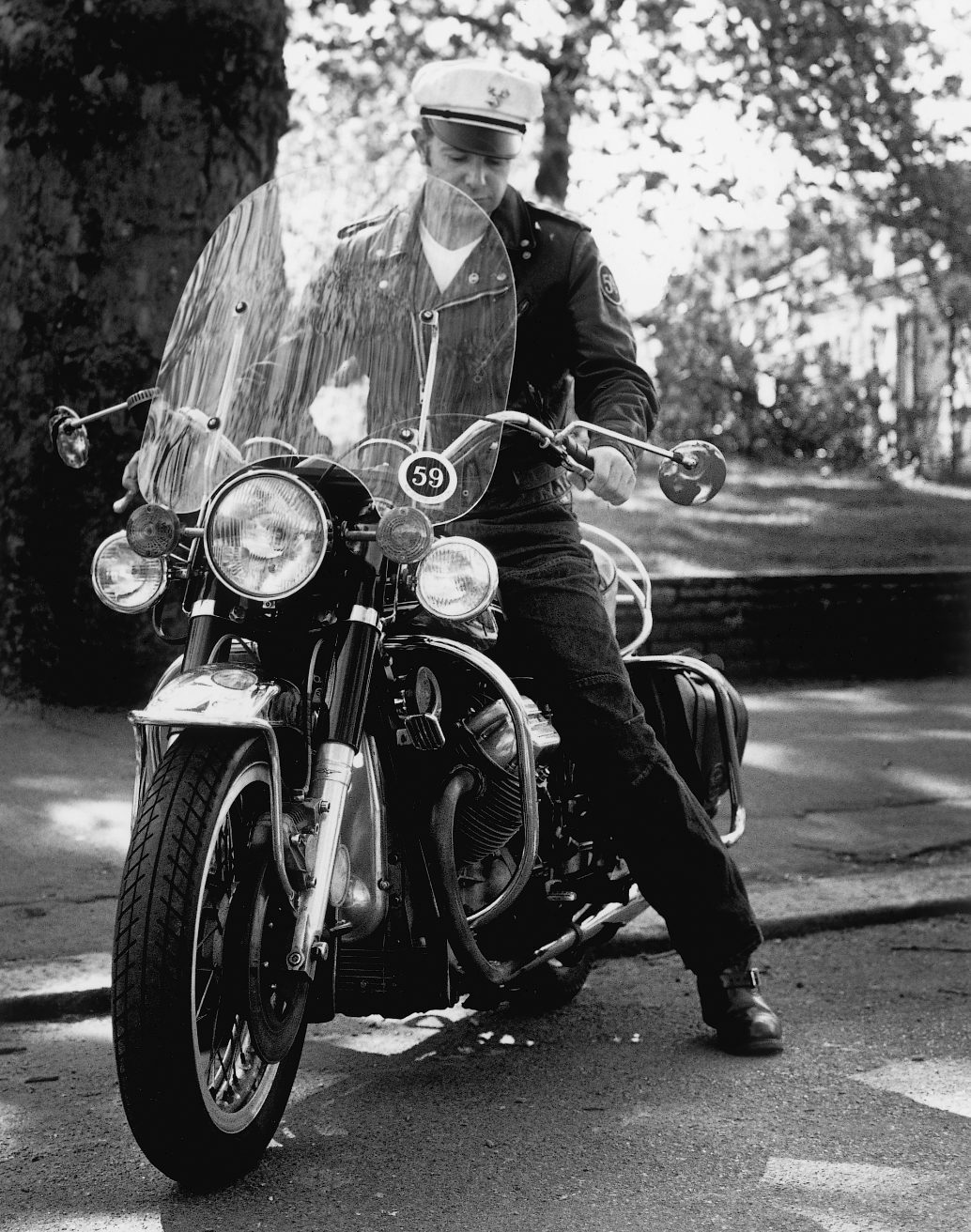Nick Clements is the founder of the magazine Men’s File. He’s a photographer best known today for documenting vintage and revivalist scenes, who himself doesn’t fit into just one area of interest but many, he's a motorcyclist, cyclist, skateboarder and surfer. Over the years Nick’s photographed Dave many times and featured The London Leatherman in his publications.
Questions by Bridget Veal Carroll
Nick circa 1995 on his Moto Guzzi 850GT California, jacket is a 1970s H-D AMF.
Q. In 2010 Dave and I bumped into you in the West End just as you were releasing issue 02 of Men’s File magazine, it was at the same time Dave and Lloyd Johnson were reviving the La Rocka! label. Your cover shoot for issue 02 captured so much of what was going on style wise in London at the time with the British rocker v Americana motorcycling look. What inspired you to launch a magazine that you’ve described as ‘A modern(ist) magazine tracing the roots of style’?
A. Dave Carroll is one of the few real Londoners I know. Many of us, who ended up in scenes in the capital in our late teens or early twenties, came from the suburbs. I lived in Surrey in the late 1970s and got all my information on style from hairdressers, the NME and films. There were many more like me. Those films were either American noir or Italian neorealism and were steeped in modernist aesthetics. The buzz of Paparazzo’s Vespa in La Dolce Vita or the click of David Hemmings’ Nikon F in Antonioni’s Blow-up were rooted in the cult of the machine, straight lines and a creative logic that seemed irresistible. Totally unoriginal, I started as a soul boy wearing pegs, Jam shoes and an American Army shirt with a tie tucked in halfway down the front. I wanted to be Bryan Ferry, but then punk and new wave arrived and pitted postmodern rock (punk) against modernist pop (new wave). All this, and so much more, formed the building blocks of Men’s File.
Q. From day one Men’s File has had a cult following with those who are committed to mid-century aesthetics. These scenes vary from vintage motorcycling to surf culture, mid-century collecting to militaria. Where does your interest in revival stem from?
A. Perhaps it started (indirectly) with the London Rock and Roll Show in 1972, when Jerry Lee Lewis, Chuck Berry and Little Richard performed at Wembley in front of an audience of Teddy boy revivalists. Without that momentum, George Lucas’ American Graffiti might not have been the success it was one year later in 1973 and that’s where I came in. In the same way that Blow-up has launched a thousand fashion photographers, American Graffiti acted as a catalyst for a nascent, car-based revival scene. That’s the problem with history, the variables, no one can say for sure, but punk rock was an interlude in all the nostalgia, that unintentionally directed people back towards revival and some confused notion of an authentic past, that had been lost and needed to be revisited and sorted out. In 1979 I was 18 and I bought a small frame Vespa 90 Special. By 1981 that had been replaced by a Consul Mk. I. A year later a 1963 Alfa Romeo Giulia spider. The die was cast.
Q. The London Leatherman has its own cult following, what’s your take on the label’s appeal to leather aficionados?
A. If you have the mind of a modernist, it’s not hard to link Bryan Ferry’s image of the mid-1970s, the drawings of Tom of Finland and Ted Post’s Magnum Force (1973). The common factor being the uniform as a medium through which style and sexuality can be expressed (for men and women). The London Leatherman follows a similar line, in that it subverts the symbolism of the uniform by repositioning its meaning. For example, through leather fetishism, words like discipline and power are shifted away from an association with the sinister apparatus of the state to the nightclub or bedroom. Machismo is reframed and redirected, while an underlying mood of chaos and anarchy are implied in the brand’s connection with punk rock. When assessing The London Leatherman, it’s hard to get Anger’s Scorpio Rising (1963) and Montgomery and Bigelow’s The Loveless (1981) out of your head. It’s clear that your label is run by enthusiasts for enthusiasts.
Q. You and your clique really did spearhead the recent fashion for heritage clothing and what’s been coined ‘vintage workwear’, which perhaps peaked commercially in 2012-2016. Is heritage clothing and vintage workwear still relevant in 2024?
A. In my previous responses I’ve tried to give some background to a style movement, that is too big to be a subculture and too small to be part of mainstream fashions. In London at least, it's based on a group of street stylists whose responses to the soul scene, punk, new wave, the new romantic event and then rockabilly and other revivals, shaped the style landscape as we see it today. Some from the first generation, like Christos Tolera and Chris Sullivan, are directly connected through the Soho club scene of the early 1980s. Others, like Dave Carroll of The London Leatherman and Lloyd Johnson are rooted in the various King’s Road-based subcultures of the 1970s. Many are unknown, except by those they influenced. What is clear is that these pre and post-punk style makers created a foundation on which alternative male dress in the capital has been formed. They tend to come from two different aesthetic schools. The first are from a linage that starts with the mods and leads to the soul boys, which I call the ‘clean’ subcultures and who tend towards order rather than chaos, as is the way of modernism. The second come from another place, in which black leather reigns supreme and the tendency is in the direction of anarchic expression. All this experimentation of the mid-20th century plays out today in the workwear look (it’s not a subculture) that, in postmodern style, incorporates a mash-up of those clean and chaotic elements. I will use the term ‘hipsters’ as I have no other, (a broad and diverse group that range from the almost avant-garde to the mainstream) come at the end of a line of style that combined historical elements and mixed leather with a crisp white shirt and engineer boots with a Savile Row suit. They took the functionality of Eddie Baur and matched that with raw denim. They walked the streets as lumberjacks and LAPD bike cops. They stood at bus stops in US Army fatigues and Red Wings. They sat in Bar Italia in Red Line Levi’s and a McGregor freezer jacket. This was 1995 and their number in London was probably less that 500 individuals. Today, that might be 50,000. Post 1995 was the start of the epoch of Japan and the replica and in terms of American workwear, we haven’t looked back since.
Q. You and Dave have many mutual interests, what subjects do you feel you mostly bond over? Clothes? Motorcycles?
A. I like to listen to Dave, as he always has something to say that I learn from.
Q. You photographed Dave and I back in 2015 for Men’s File, which was a wonderful experience. You were devoted to getting the shot you wanted and have a talent for directing your subjects quite specifically. Amongst the thousands of photoshoots you’ve done, do you have a favourite?
A. I have enjoyed too many shoots to pick one.
Q. Our mutual friend Jasper James assisted you for a time in the 90s, he once said you were famous for lighting and how you set up lighting for a shot, this was of course at the time when you used film and good lighting was imperative. Do you still shoot film or only digital these days?
A. That’s kind of Jasper, to mention me. Jasper is a serious photographer today and I often look at his work. In terms of my own lighting, I still use film lights if they are around. However, I rarely use more than two lights.
Q. Leather clothing’s timeless and crosses over so many sub-cultures, styles, eras. Why do you think leather’s so stylish?
A. I gave some long answers above that probably answer that question. However, it’s something to do with its connection with the uniform, combined with functionality.
Nick circa 2017 wearing a Himel Bros. leather jacket.
Q. You yourself have many, many, many leather jackets. Do you wear leather day to day or just for motorcycling?
A. I mainly wear my leather jackets on the bike, however, I have a lightweight Lewis Leathers jacket that is great to wear all the time.
Q. What’s the best motorcycle you’ve owned and is there a motorcycle you hope to own one day?
A. I have owned (3 slightly different models) of, what is for me, the best motorcycle, The Moto Guzzi 850GT California.
Q. Are you working on any projects this year you can tell us about here?
A. I’m working on another photo-book in the Unseen Scene series. That will be available on the Men’s File website in March 2024. www.mensfile.com
Issue 02 of Mensfile Magazine, circa 2010.



